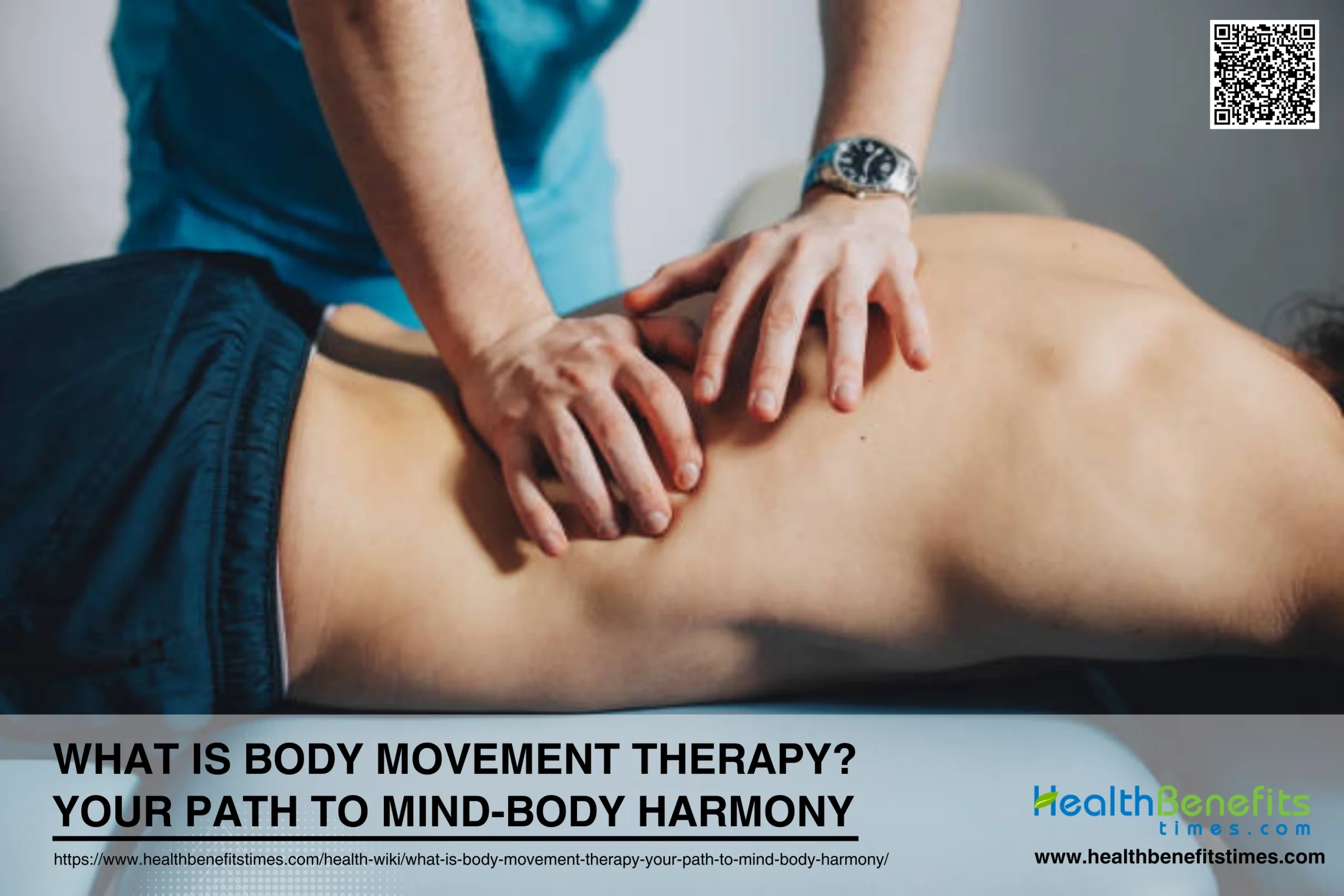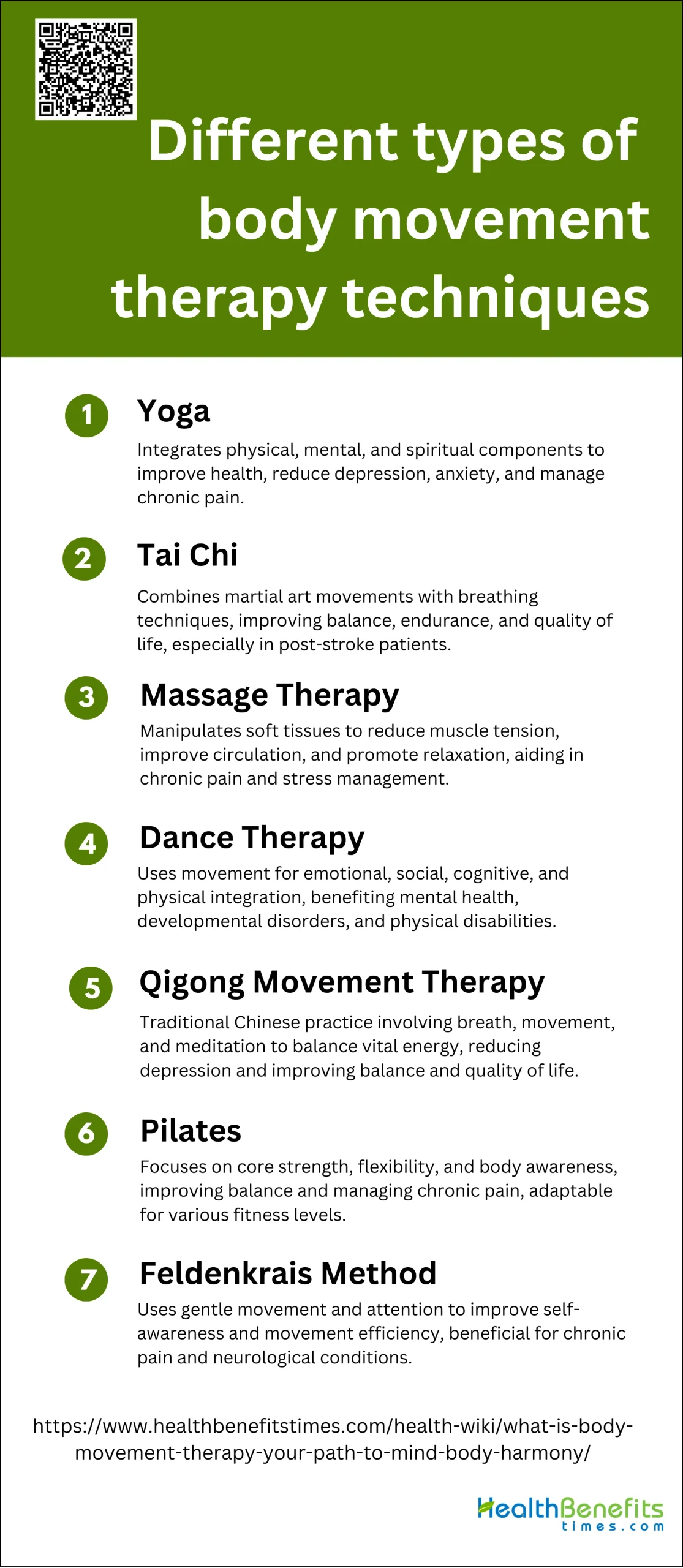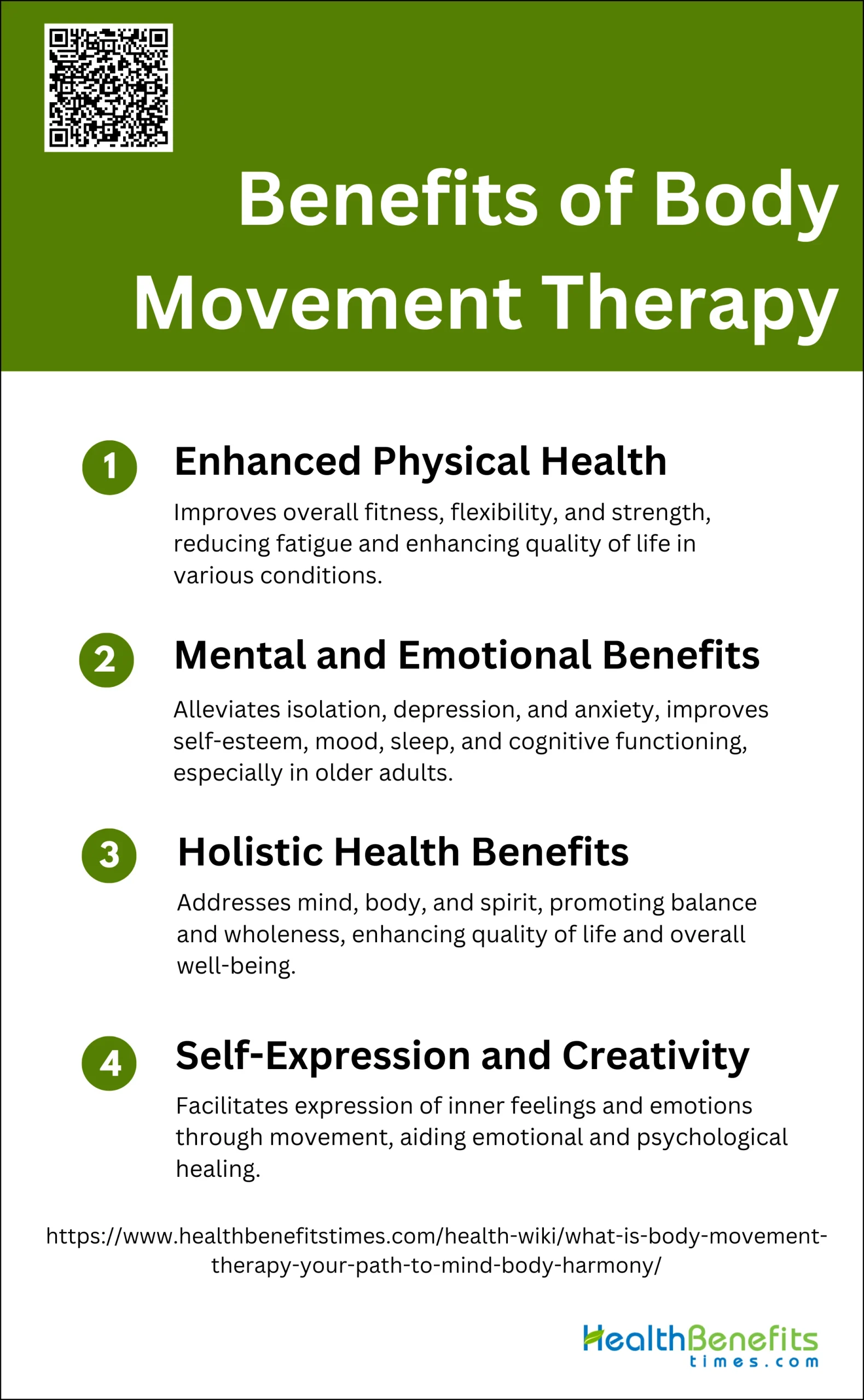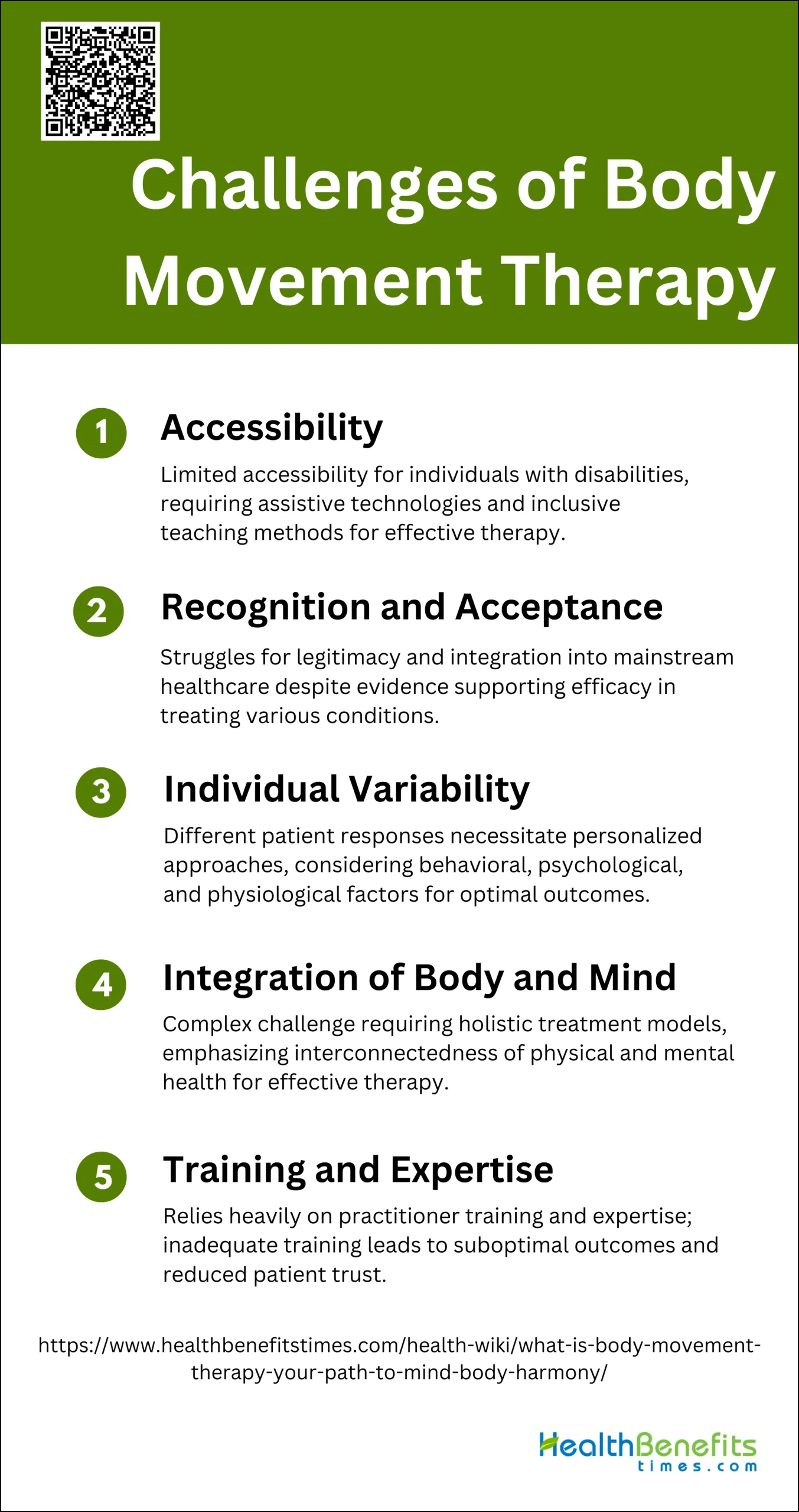 Body Movement Therapy is a holistic approach that utilizes various forms of physical movement to enhance the physical, mental, and emotional well-being of individuals. This therapy encompasses a range of practices, including yoga, tai chi, qigong, massage, and dance movement therapy (DMT), each designed to improve cognitive function, reduce stress, and increase self-awareness and flexibility. By integrating body movement with psychotherapeutic techniques, Body Movement Therapy aims to treat symptoms of illness, regulate mood and behavior, and improve the quality of life for patients with conditions such as chronic obstructive pulmonary disease (COPD), anxiety, depression, and physical disabilities. Sessions are tailored to individual needs and can be conducted one-on-one or in groups, promoting a comprehensive sense of wellness through the interconnectedness of mind, body, and spirit.
Body Movement Therapy is a holistic approach that utilizes various forms of physical movement to enhance the physical, mental, and emotional well-being of individuals. This therapy encompasses a range of practices, including yoga, tai chi, qigong, massage, and dance movement therapy (DMT), each designed to improve cognitive function, reduce stress, and increase self-awareness and flexibility. By integrating body movement with psychotherapeutic techniques, Body Movement Therapy aims to treat symptoms of illness, regulate mood and behavior, and improve the quality of life for patients with conditions such as chronic obstructive pulmonary disease (COPD), anxiety, depression, and physical disabilities. Sessions are tailored to individual needs and can be conducted one-on-one or in groups, promoting a comprehensive sense of wellness through the interconnectedness of mind, body, and spirit.
Different types of body movement therapy techniques
Body movement therapy encompasses a variety of techniques aimed at improving physical and mental well-being through movement. These therapies can help enhance flexibility, strength, and relaxation, and are often used in both clinical and wellness settings. Below are some of the most popular types of body movement therapy techniques:
1. Yoga
Yoga is a mind-body exercise that integrates physical, mental, and spiritual components to improve overall health. It involves a combination of muscular activity and mindful focus on awareness of the self, breath, and energy. Yoga has been shown to reduce depression, anxiety, and improve balance and quality of life, particularly in post-stroke patients. Additionally, it has demonstrated beneficial effects on sleep disturbances, fatigue, and health-related quality of life in individuals with fibromyalgia syndrome. Yoga is also effective in managing chronic non-specific low back pain, ranking highly in improving physical function.
2. Tai Chi
Tai Chi is a traditional Chinese martial art that combines martial art movements with vital energy circulation, breathing, and stretching techniques. It consists of a series of graceful movements with deep and slow diaphragmatic breathing performed while standing. Tai Chi has been shown to have both physical and psychosocial benefits, including improvements in balance, reaction time, aerobic endurance, and quality of life in post-stroke patients. It is also effective in reducing depressive symptoms and improving body composition, particularly body mass index. Tai Chi is considered one of the most popular mind-body exercises for enhancing integrative health and well-being.
3. Massage Therapy
Massage therapy involves the manipulation of soft tissues to improve health and well-being. While the provided data does not specifically address massage therapy, it is generally recognized for its benefits in reducing muscle tension, improving circulation, and promoting relaxation. Massage therapy can be an effective complementary treatment for various conditions, including chronic pain, anxiety, and stress. It is often used in conjunction with other therapies, such as physical therapy and exercise, to enhance overall treatment outcomes.
4. Dance Therapy
Dance therapy, also known as dance/movement therapy, uses movement to promote emotional, social, cognitive, and physical integration. Although the provided data does not specifically address dance therapy, it is known to be beneficial for individuals with mental health issues, developmental disorders, and physical disabilities. Dance therapy can improve mood, reduce anxiety, and enhance physical coordination and flexibility. It is a holistic approach that encourages self-expression and emotional release through movement.
5. Qigong Movement Therapy
Qigong is a traditional Chinese practice that involves a series of breath practices, body movements, and meditation to attain deep focus and a relaxed state. It is used to cultivate the balance and harmony of vital energy in the human body. Qigong has been shown to reduce depressive symptoms and improve health-related quality of life in various populations. It is also effective in improving balance, reaction time, and quality of life in post-stroke patients. Qigong is considered a safe and accessible form of meditative movement therapy with numerous health benefits.
6. Pilates
Pilates is a mind-body exercise that focuses on strengthening the core muscles, improving flexibility, and enhancing overall body awareness. It has been shown to improve quality of life, functional balance, and dynamic balance in post-stroke patients. Pilates is also effective in managing chronic non-specific low back pain, ranking highly in reducing pain intensity and improving physical function. It is a versatile exercise modality that can be adapted to various fitness levels and health conditions, making it a popular choice for rehabilitation and general fitness.
7. Feldenkrais Method
The Feldenkrais Method is a form of somatic education that uses gentle movement and directed attention to improve movement patterns and overall well-being. It is designed to increase self-awareness and enhance the efficiency and ease of movement. Although the provided data does not specifically address the Feldenkrais Method, it is known to be beneficial for individuals with chronic pain, neurological conditions, and movement disorders. The method can improve flexibility, coordination, and balance, and is often used in rehabilitation settings to support recovery and enhance quality of life.
Benefits of Body Movement Therapy
Body movement therapy offers numerous advantages for both physical and mental health. It can improve flexibility, enhance muscle strength, and promote relaxation, making it a valuable addition to any wellness routine. Below are some key benefits of body movement therapy:
1. Enhanced Physical Health
Body movement therapy significantly enhances physical health by promoting overall fitness, flexibility, and strength. It encourages proactive participation in one’s health, creating a foundation for successful, permanent, positive change. For instance, dance/movement therapy has been shown to improve physical outcomes in cancer patients, such as reducing fatigue and enhancing quality of life. Additionally, physical therapists have observed that promoting movement quality through body awareness can lead to better physical function and overall health.
2. Mental and Emotional Benefits
Movement therapy offers substantial mental and emotional benefits. It helps individuals reconnect with their bodies, build self-confidence, and express emotions, which can alleviate feelings of isolation, depression, and anxiety. Dance/movement therapy, for example, integrates physical, emotional, and social experiences to create healthier self-esteem and improve mental health. Moreover, mind-body therapies have been found effective in enhancing mood, sleep, and cognitive functioning, particularly in older adults.
3. Holistic Health Benefits
Movement therapy supports holistic health by addressing the mind, body, and spirit concurrently. This approach is rooted in the belief that movement and emotion are directly related, promoting a sense of balance and wholeness. Techniques such as tai chi and dance are used to integrate the body experience into a therapeutic whole, facilitating deeper healing and personal growth. Additionally, holistic approaches in therapy, complemented with bodywork, have shown significant improvements in patients’ quality of life and overall well-being.
4. Self-Expression and Creativity
Body Movement therapy provides a unique avenue for self-expression and creativity. It allows individuals to use their bodies to express inner feelings and emotions, which can be particularly therapeutic. Dance has historically been a form of self-expression and communication, and its therapeutic use helps individuals find a healthy balance and sense of wholeness. Techniques such as creative dance and physical storytelling are employed to enhance self-expression and creativity, contributing to emotional and psychological healing.
Who Can Benefit from Body Movement Therapy
Body movement therapy is beneficial for a wide range of individuals, from those recovering from injuries to those seeking to improve their overall well-being. It can be tailored to suit various age groups and fitness levels, making it accessible to almost everyone. Below are some groups of people who can benefit from body movement therapy:
1. People with Mental Health Issues
Body movement therapy has shown significant potential in addressing mental health issues, particularly trauma. Engaging the body in trauma treatment can reduce the length of treatment by addressing the connections among thoughts, feelings, neurobiology, and somatic responses in survivors. This approach can help individuals process and express their emotions more effectively, leading to improved mental health outcomes. Additionally, body-centered interventions like dance/movement therapy have been found to alleviate stress, depression, and anxiety, making them valuable tools for mental health care practitioners.
2. Individuals with Developmental and Learning Disabilities
Movement therapy can be particularly beneficial for individuals with developmental and learning disabilities. Techniques such as creative dance and afspaending help these individuals become more aware of their bodies and use movement to express inner feelings, which can be crucial for their emotional and cognitive development. By integrating body movement into therapeutic practices, individuals with developmental and learning disabilities can experience enhanced communication skills and emotional expression, contributing to their overall well-being.
3. Individuals Recovering from Injury or Surgery
For individuals recovering from injury or surgery, movement therapy, including constraint-induced movement therapy (CIMT), has proven effective. CIMT involves constraining the non-affected limb to encourage the use of the affected limb, thereby improving motor function and daily activities. This therapy has shown beneficial effects on motor function, arm-hand activities, and self-reported arm-hand functioning in daily life, both immediately after treatment and at long-term follow-up. Movement-based therapies promote proactive participation in one’s own health, fostering successful rehabilitation outcomes.
4. Children and Adolescents
Children and adolescents can greatly benefit from movement therapy, especially those dealing with eating disorders. Movement therapy helps these young individuals address body-related fear and shame, which are common in eating disorders. A novel multidyadic movement group therapy model, involving patient-staff dyads, has shown highly positive impacts by providing body-related modeling and adequate containment from the staff. This approach helps adolescents develop a healthier relationship with their bodies and improves their emotional and social well-being.
5. Individuals with Cardiovascular Conditions
Movement therapy can also benefit individuals with cardiovascular conditions by promoting overall health and wellness. Engaging in mindful movement-based practices, such as tai-chi and yoga, can improve cardiovascular health by reducing stress and enhancing physical fitness. These therapies encourage proactive participation in one’s health, creating a foundation for successful, permanent, positive change. By incorporating movement therapy into their routines, individuals with cardiovascular conditions can experience improved physical and psychological outcomes.
6. Individuals Seeking General Health and Wellness
For those seeking general health and wellness, movement therapy offers a holistic approach to maintaining physical and mental well-being. Practices like dance, yoga, and tai-chi promote body awareness, flexibility, and strength, contributing to overall health. These therapies encourage individuals to take an active role in their health, fostering community support and accountability, which are essential for sustaining long-term wellness. By integrating movement therapy into their daily lives, individuals can achieve a balanced and healthy lifestyle.
7. Elderly Individuals
Elderly individuals can benefit from movement therapy by improving their physical and mental health. Movement-based therapies, such as tai-chi and yoga, enhance balance, flexibility, and strength, reducing the risk of falls and improving overall mobility. These therapies also promote mental well-being by reducing stress and anxiety, which are common in older adults. By participating in movement therapy, elderly individuals can maintain their independence and improve their quality of life.
8. Individuals with Neurological Conditions
Individuals with neurological conditions, such as stroke survivors, can benefit from movement therapy, particularly constraint-induced movement therapy (CIMT). CIMT has been shown to improve motor function and daily activities by encouraging the use of the affected limb. This therapy helps individuals optimize the use of intact end-effectors, leading to better rehabilitation outcomes. Movement therapy can also enhance neuroplasticity, promoting recovery and improving the overall quality of life for individuals with neurological conditions.
9. Athletes and Performers
Athletes and performers can benefit from movement therapy by enhancing their physical and mental performance. Techniques such as dance and body awareness therapies improve flexibility, strength, and coordination, which are essential for peak performance. Movement therapy also helps athletes and performers manage stress and anxiety, contributing to better mental focus and resilience. By incorporating movement therapy into their training routines, athletes and performers can achieve optimal performance and maintain their overall well-being.
Challenges of Body Movement Therapy
While body movement therapy offers numerous benefits, it also comes with its own set of challenges. These can range from physical limitations and accessibility issues to the need for specialized training and individualized treatment plans. Below are some of the key challenges associated with body movement therapy:
1. Accessibility
Accessibility remains a significant challenge in body movement therapy, particularly for individuals with disabilities such as blindness or low vision (BLV). Traditional methods often rely heavily on visual cues and physical demonstrations, which are not accessible to BLV individuals. This necessitates the development of assistive technologies and inclusive teaching methods that cater to their unique needs. Recent studies emphasize the importance of co-designing solutions with the BLV community to ensure that these technologies and methods are effective and user-friendly. Additionally, remote delivery of therapies, such as the Empower Veterans Program (EVP) Mindful Movement framework, has shown promise in making these therapies more accessible to a broader audience.
2. Recognition and Acceptance
The recognition and acceptance of body movement therapies, such as Dance Movement Therapy (DMT), face hurdles within the broader medical and psychological communities. Despite growing evidence supporting their efficacy in treating various mental health conditions and enhancing overall well-being, these therapies often struggle for legitimacy and integration into mainstream healthcare. For instance, DMT’s potential in addressing trauma and mental health challenges is well-documented, yet it remains underutilized in clinical settings. The debate surrounding the Doctor of Physical Therapy (DPT) degree in Pakistan highlights similar issues, where new educational standards and professional recognition are met with both excitement and skepticism.
3. Individual Variability
Individual variability poses a significant challenge in the application and effectiveness of body movement therapies. This variability can be seen in responses to treatments like CD19 CAR-T cell therapy, where different patients exhibit diverse efficacy and toxicity profiles. Similarly, in the context of physical therapy for chronic pain, the variability in patient responses necessitates personalized approaches that consider behavioral, psychological, and physiological factors. Understanding and modeling this variability is crucial for optimizing therapeutic outcomes and ensuring that interventions are tailored to meet the unique needs of each individual.
4. Integration of Body and Mind
Integrating the body and mind is a core principle of many body movement therapies, yet it remains a complex challenge. Therapies like DMT emphasize the interconnectedness of physical and mental health, advocating for a holistic approach to treatment. Research underscores the importance of building interoceptive awareness and externalizing trauma to achieve bodily reintegration and mental well-being. This integration is particularly vital in treating conditions like schizophrenia, where enhancing bodily awareness can improve medication compliance and reduce side effects. The dualistic foundation of medical and psychological spaces in the U.S. often complicates this integration, necessitating a shift towards more holistic therapeutic models.
5. Training and Expertise
The effectiveness of body movement therapies heavily relies on the training and expertise of practitioners. Inadequate training can lead to suboptimal outcomes and reduced patient trust, as seen in the treatment of temporomandibular joint disorders. The evolving landscape of physical therapy, with new degrees like the DPT, highlights the need for continuous professional development and updated educational standards. Additionally, the integration of advanced technologies in neurorehabilitation requires specialized knowledge to effectively harness these tools for patient benefit. Ensuring that practitioners are well-trained and knowledgeable is essential for the successful implementation and acceptance of body movement therapies.





